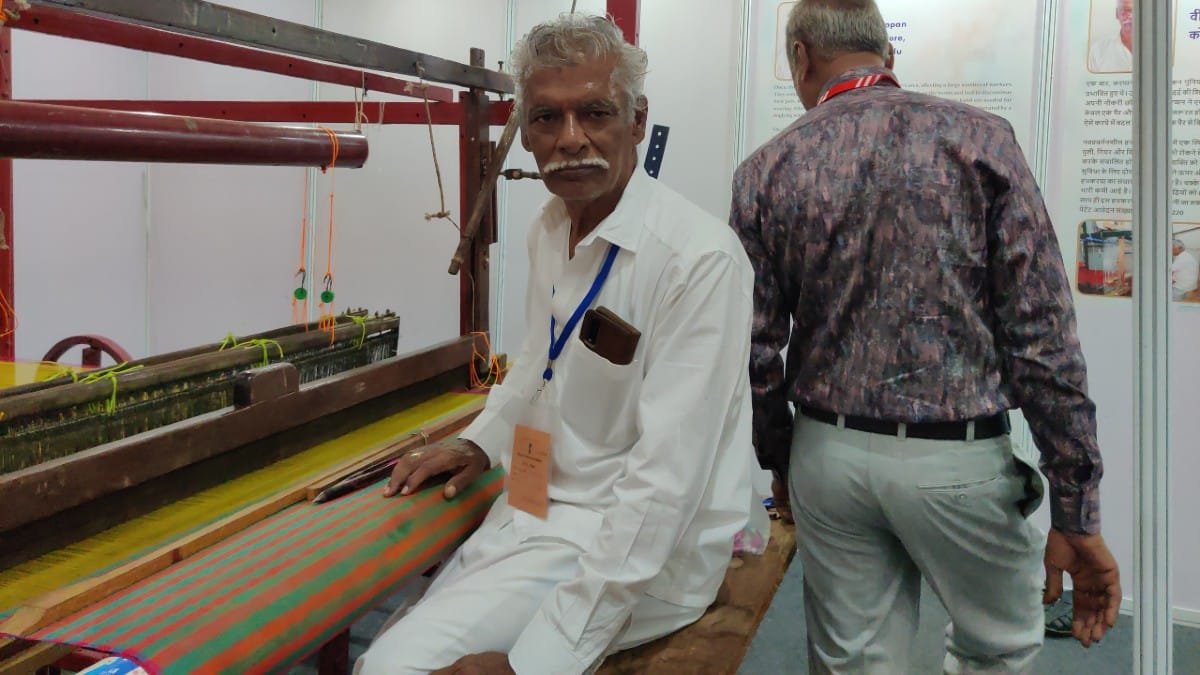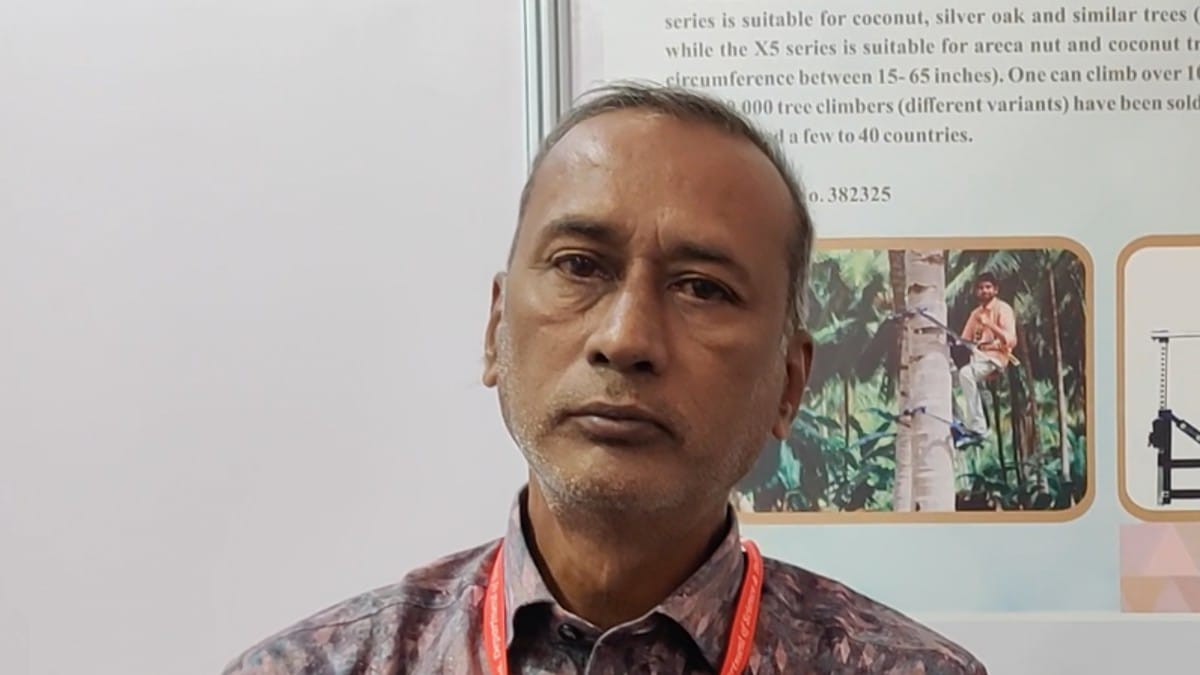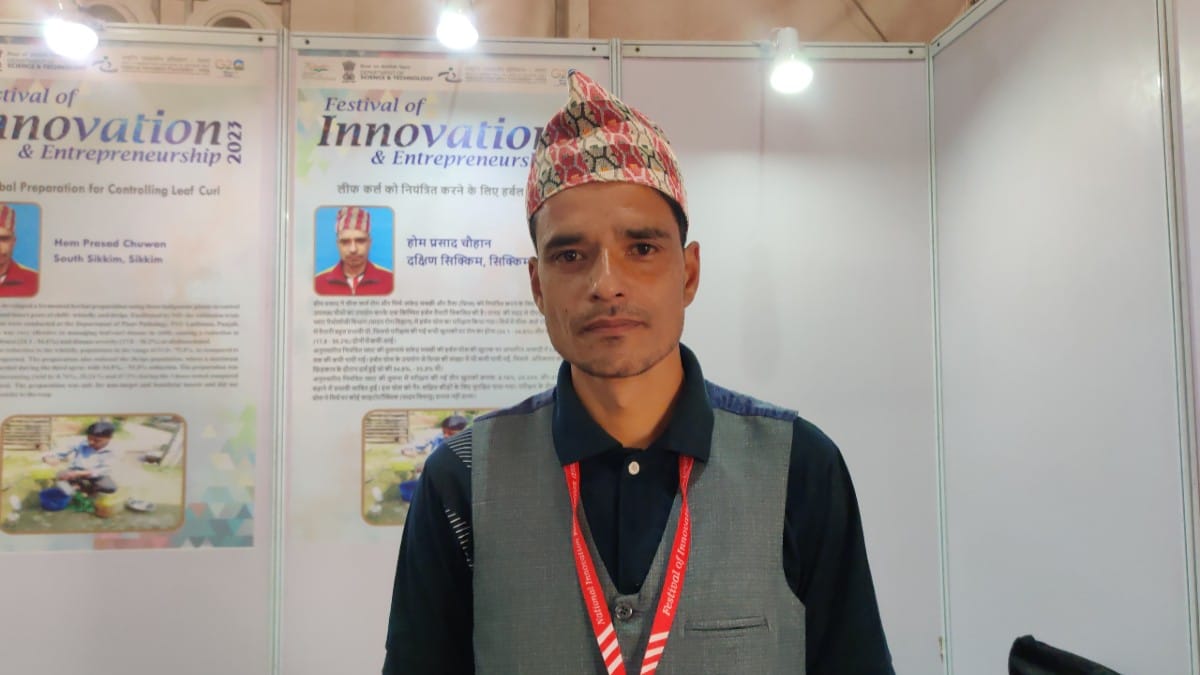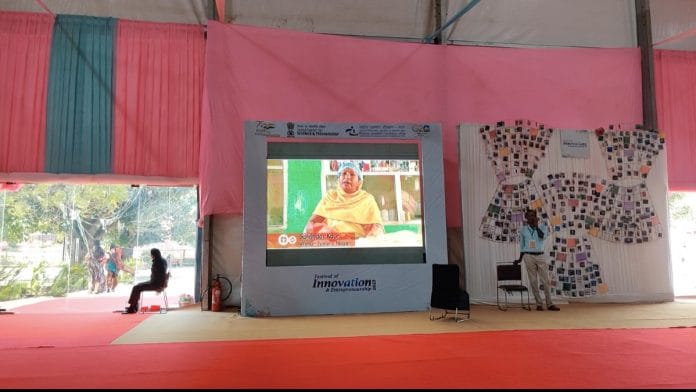New Delhi: His eyes gleamed with pride, as V. Karappan watched the handloom churn out intricately woven Kanchipuram silk sarees, in mesmerising colour palettes of red, blue and green. The master weaver was using just one leg to operate the machine — his unique invention.
The seventy-three year old was showcasing his skills Tuesday at the ‘Festival of Innovation and Entrepreneurship (FINE)’ – 2023, organised near the Rashtrapati Bhavan Cultural Centre (RBCC), a day after he was conferred the ‘state award’ for his invenction by President Droupadi Murmu for his design.
A resident of Tamil Nadu, Karappan devised a handloom that can be operated using just one leg, as opposed to traditional machines, after losing strength in part of his body following a bout of Chikungunya infection. The innovating design can be operated by the differently-abled and also help revive the waning community of weavers around the country, he said.

“It is very useful to bring the next generation in this business who leave their family business to pursue some other job,” he told ThePrint, citing its superior speed and ease of operation.
Karappan was one of 51 awardees from rural backgrounds felicitated by the President at the 11th Biennial National Grassroots Innovation and Outstanding Traditional Knowledge Awards held in Delhi Monday. The awards were presented across eight categories — Lifetime Achievement Awards, National Awards (for first, second and third positions), State Awards, Consolation Awards, Appreciation Awards and Student Awards.
The awards are an annual affair organised by the National Innovation Foundation-India (NIF), an autonomous body under the central government’s Department of Science and Technology. The NIF is known to scout distant parts of the country to identify Indians who have used traditional knowledge, without any technical support from external agencies, to invent something novel that can help the country at large.
A founding member of the NIF, former IIM-Ahmedabad professor Anil K. Gupta told ThePrint that the body helped thousands of innovators from remote parts of India to secure patents, investment and recognition.
“Intellectual property rights (IPR) work not just for big corporations but also for the poor, whose only resource is knowledge. This same knowledge surpassed even the educated. The focus right now is only on urban startups, the next phase would be tiers 2 and 3, when will it come to rural? Large amounts of wealth are concentrated in some areas. Instead, small pots of wealth should be distributed to generate social welfare impact,” said Gupta.
Also Read: This veiled jal saheli & her all-women team revived a river. Their village is now thriving
Bout of Chikungunya spurred invention
Karappan said he built his handloom machine after having suffered a severe bout of Chikungunya infection in 2004. The disease, which claimed was widespread in his Sirumugai village, left the masterweaver weak in one part of his body, to the extent that he was unable to work the traditional loom which requires the use of both hands and feet.
“I have had no formal education. I used my hard-earned money and my savings to purchase material and it took me some years to build it [his innovative loom]. But now, I can say with certainty that it could be used by any weak, partially paralysed, people with joint pain or even an unskilled person. Additionally, it cuts the time of producing one saree from 18 to 6 hours,” he explained.
The machine includes a static and dynamic body frame, an oscillating frame made of wood pulleys, gears and a band brake to halt power transmission. It takes between Rs 75,000 and Rs 1 lakh to set up this machine, said Karappan, adding that the government could either assist him, mass-produce it or advocate its widespread usage.
He added: “There is a lot of demand for handloom products but people are not interested in this business since it takes a lot of time to produce sarees. No one below the age of 40 is in this business. Generally, it would take three to four years to master the skill of handloom because stringent hand and leg coordination is required, but I have made it simple. Now, only 10 minutes can be required to learn this.”
He added that his invention can also “light up a bulb with minimum manual effort”.
Death & misery — the life of tree climbers
D.N. Venkat, another awardee from Tamil Nadu, said it was a pity that textiles underwent modernisation and even pottery-makers shifted from traditional to mechanised methods, while those working as tree-climbers for generations were still using hands or ropes to carry out their work.
It was this thought that motivated him to build a contraption professional tree-climbers could use to climb up and down a tree in a sitting posture, while being in a locked arrangement, without fear of falling down.

Raised in an agrarian household, Venkat spent 25 years working at a textile mill owing to the childhood trauma of witnessing a tree climber injuring himself at Venkat’s family-owned coconut farm in Coimbatore.
“At that time, there was no mechanism to climb trees safely and such incidents were quite common. That one accident was especially difficult to witness as the man who got hurt was the only breadwinner in his family,” he recalled.
The year was 1999, Venkat — by then married and a father of two — was out of a job and working odd jobs as a plumber or an electrician. It was during this time that he learnt to weld, drill and work machinery while working at his uncle’s workshop where he was producing pumps.
“I later returned to coconut farming but the memories of accidents haunted me and around 2003-2005, I started working on a tree-climbing machine that could prevent those instances. I have studied only till Class 8 but learnt the mechanics part of it from other jobs I had done in the past,” Venkat told ThePrint.
The contraption initially had a wooden frame and it was in 2008 that Venkat was able to complete a working prototype. Around the same time (2008-09), the SEWA NGO, part of the Honey Bee Network that collaborated with the NIF, discovered his invention.
The Honey Bee Network and the NIF helped Venkat secure a loan of Rs 3 lakh in 2013, which he used as working capital to purchase material and produce more inventory, pricing it at Rs 10,000 to make it affordable for farm owners.
“It took some time to develop a proper model because once I ventured into it, I found that trees were not always straight and their girth varied drastically from top to bottom. Once it was done, my friend called the local print Tamil media and it quickly got viral. Since there were shortages of coconut tree climbers, we started getting many orders,” he added.
His son Sree Vardhan, an MBA graduate, took over the business in 2015 and modified the design to turn the invention into a multi-tree climber.
“I’ve sold more than 10,000 units and not just in India. I have also started exporting and made the business profitable. Now, the device can also be used to climb silver oak, palm, timber, ornamental trees, etc. without damaging the trunk. It doesn’t even require any prior skill,” said Sree Vardhan.
Also Read: By 2025, rural India will likely have more internet users than urban India
‘Organic medicine’ to counter leaf curl disease
Hom Prasad Chuwan, one of the recipients of the ‘appreciation award’ handed out by President Murmu, has formulated a fermented herbal preparation using indigenous plants to control leaf curl disease that was rampant in the farms in his village.
Characterised by the distortion and discoloration of leaves, the disease destroys crops by making them hollow from the inside. The 40-year-old from South Sikkim said the chemical or inorganic pesticides he used to protect his crops caused itching and allergic reactions.
“I believe my father got cancer because of those pesticides. Many others in our villages had also suffered illnesses,” he told ThePrint.

Chuwan said he learnt about the benefits of organic farming during his visit to Haryana in 2009 as head of a group of 22 farmers from South Sikkim who visited the state as part of a Sikkim government initiative.
Upon his return, Chuwan prepared his own ‘organic medicine’ that suited the environs of hilly regions like Sikkim. He believed the concoction had to adapt because crops grown in his home state — like chilies, ginger, potatoes and tomatoes — were different from those grown in Haryana.
A ‘validation trial’ at the Punjab Agricultural University (PAU) in Ludhiana found it to be ‘effective’ in managing leaf curl disease in chilly. Chuwan added that he wants to bring his product to the market and work with the Sikkim government’s agriculture or science departments to develop more such concoctions in the future.
He, however, said a second trial will be conducted before the concoction can be launched for commercial use.
NIF, Honey Bee Network, Srishti & GIAN
The journey of NIF started with the Honey Bee Network 35 years ago, which has been working since to recognise, respect and reward knowledge-rich but economically poor people at the grassroots. Its name signifies a network that cross-pollinates ideas from one part of the country to the other.
The network created a knowledge database of expertise collected by and disseminated to a wide range of individuals from the grassroots while observing ethical practices of credit, compensation, and accessibility.
In 1993, Srishti came into existence. A voluntary organisation aiming to strengthen the creativity of grassroots communities and innovators, it supported eco-friendly solutions to local problems.
The next step in this journey was the inception of the Gujarat Grassroots Innovations Augmentation Network (GIAN) in 1997. An ‘incubator’ set up with the support of the Gujarat government, its aim was to scale up and spawn grassroots innovations and help promising entrepreneurs grow. It did so by providing adequate linkages to modern science and technology, market research, design institutions and funding organisations.
In 2003, three patents were filed by GIAN on behalf of three rural innovators, one of which was acquired by a multi-corporation. GIAN’s model was eventually scaled in 1999.
Though NIF started with an investment of Rs 20 crore against the demand of Rs 200 crore, its illustrious and distinguished board members and volunteers have pushed it to great heights.
While Gupta stepped down from NIF in 2018, he remained a board member and said he is grateful to the government for offering a platform such as FINE – 2023 which has the potential to change the lives of these rural innovators by giving them “visibility, voice and velocity”.
(Edited by Amrtansh Arora)
Also Read: WEF-backed Schwab Foundation names top social innovators for this year, 5 Indians on list






